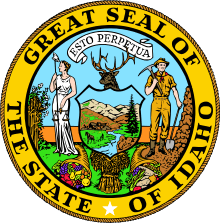N. B. Willey
| N. B. Willey | |
|---|---|
.jpg) Willey as depicted in 1904's National Cyclopaedia of American Biography. | |
| 2nd Governor of Idaho | |
|
In office December 18, 1890 – January 2, 1893 | |
| Lieutenant | John S. Gray |
| Preceded by | George L. Shoup |
| Succeeded by | William J. McConnell |
| 1st Lieutenant Governor of Idaho | |
|
In office October 1, 1890 – December 18, 1890 | |
| Governor | George L. Shoup |
| Preceded by | Position established |
| Succeeded by | John S. Gray |
| Personal details | |
| Born |
March 25, 1838 Guilford, New York |
| Died |
October 20, 1921 (aged 83) Topeka, Kansas |
| Political party | Republican |
| Residence | Warren, Idaho |
| Profession | Mining |
| Religion | Protestant |
Norman Bushnell Willey (March 25, 1838 – October 20, 1921) was the second Governor of Idaho from 1890 until 1893.
Biography
Born in Guilford, New York, Willey was educated at the Delaware Literary Institute in Franklin, New York.[1]
Career
Willey moved to California at the age of twenty where he began his career in the mining industry. He followed the Gold rush to Idaho in 1864; after working some time there, he was promoted to the position of superintendent of lode mine. During his lengthy tenure in that position, he began a political career. Elected as Superintendent of Schools, he was not reelected in 1868.
Willey was elected to Idaho's legislative assembly in 1872, held the position until 1873. Reelected in 1878, he served as Council President in 1879, and continued in office as a House Member until 1889. This was a remarkable achievement, as he was one of the few on the council who opposed the effort to reunite North Idaho with Washington State.[2] In 1888, he was not reelected for a third term. During his two terms, he became friends with Milton Kelly – a former supreme court justice who had become a prominent newspaper editor. This led to a career in the field of journalism, where his reports as mine superintendent and state correspondent found wide audience.[3]
In 1890, another opportunity arose for Willey in politics when Idaho gained admission as a state. Although Idaho at the time preferred to have a senator, they were granted a governor. George Shoup was chosen to serve as governor; however, he only agreed to do so once he was assured that his service would end as governor in late 1890, and that he would then become a senator. Shoup arranged Willey's election as Lieutenant Governor, which assured him the position of Governor for the state after Shoup had vacated the position. He continued to serve as governor until 1892, where he was ousted by other political factions.[4]
Death
Willey died on October 20, 1921. He is interred at Auburn Cemetery, Shawnee County, Kansas USA.[5]
References
- ↑ "N. B. Willey". National Governors Association. Retrieved 15 September 2012.
- ↑ "N. B. Willey". National Governors Association. Retrieved 15 September 2012.
- ↑ "N. B. Willey". Find A Grave. Retrieved 15 September 2012.
- ↑ "N. B. Willey". The Political Graveyard. Retrieved 15 September 2012.
- ↑ "N. B. Willey". Find A Grave. Retrieved 15 September 2012.
External links
| Wikimedia Commons has media related to N. B. Willey. |
| Political offices | ||
|---|---|---|
| Preceded by (none) |
Lieutenant Governor of Idaho October 1890 – December 1890 |
Succeeded by John S. Gray |
| Preceded by George L. Shoup |
Governor of Idaho December 1890 – January 1893 |
Succeeded by William J. McConnell |
